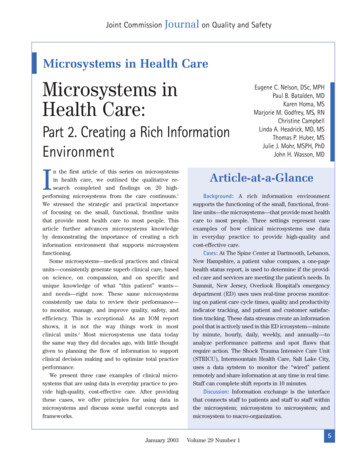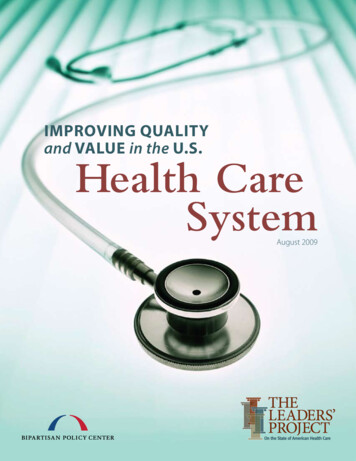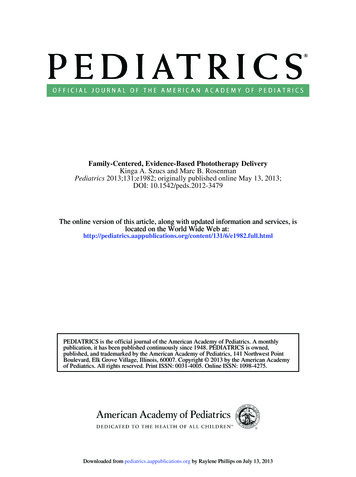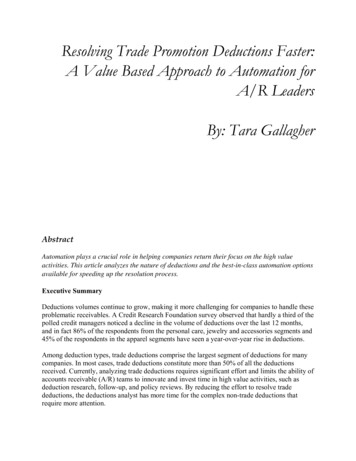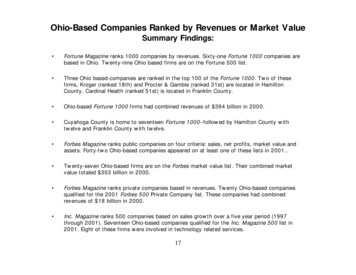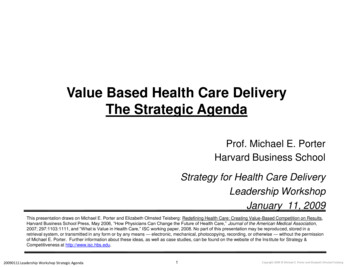
Transcription
Value Based Health Care DeliveryThe Strategic AgendaProf. Michael E. PorterHarvard Business SchoolStrategy for Health Care DeliveryLeadership WorkshopJanuary 11, 2009This presentation draws on Michael E. Porter and Elizabeth Olmsted Teisberg: Redefining Health Care: Creating Value-Based Competition on Results,Harvard Business School Press, May 2006, ―How Physicians Can Change the Future of Health Care,‖ Journal of the American Medical Association,2007; 297:1103:1111, and ―What is Value in Health Care,‖ ISC working paper, 2008. No part of this presentation may be reproduced, stored in aretrieval system, or transmitted in any form or by any means — electronic, mechanical, photocopying, recording, or otherwise — without the permissionof Michael E. Porter. Further information about these ideas, as well as case studies, can be found on the website of the Institute for Strategy &Competitiveness at http://www.isc.hbs.edu.20090111 Leadership Workshop Strategic Agenda1Copyright 2009 Michael E. Porter and Elizabeth Olmsted Teisberg
Value-Based Health Care DeliveryExecutive Education Course The Leadership Workshop on Strategy for Health Care Delivery isan intensive, two day workshop on the principles of value-basedhealth care delivery, examining organizations working toimplement those principles in practice.20090111 Leadership Workshop Strategic Agenda2
Participants71 Leaders from Health Care Organizations Worldwide 37 Hospital/Provider Organization CEO’s and Senior Executives 10 Chief Medical/Clinical Officers 2 Chief Nursing Officers 7 Health Plan CEO’s and Senior Executives 4 Educators 9 Government Officials 2 Health Care Philanthropists/ Board MembersCountries United States (48) Canada (13) Finland (4)Sweden (3)Germany (2)Taiwan (1)20090111 Leadership Workshop Strategic Agenda3Copyright 2009 Michael E. Porter and Elizabeth Olmsted Teisberg
Faculty Michael E. Porter, Harvard Business School, Course Head Elizabeth Olmsted Teisberg, University of Virginia, DardenGraduate School of Business Administration Robert Huckman, Harvard Business School Sachin Jain, Research Fellow, Institute for Strategy andCompetitiveness Scott Wallace, Batten Fellow, University of Virginia, DardenGraduate School of Business20090111 Leadership Workshop Strategic Agenda4
Redefining Health Care Delivery Universal coverage and access to care are essential, but notenough The core issue in health care is the value of health caredeliveredValue: Patient health outcomes per dollar spent How to design a health care system that dramatically improvesvalue– Ownership of entities is secondary (e.g. non-profit vs. for profit vs.government) How to create a dynamic system that keeps rapidly improving20090111 Leadership Workshop Strategic Agenda5Copyright 2009 Michael E. Porter and Elizabeth Olmsted Teisberg
Creating a Value-Based Health Care System Significant improvement in value will require fundamentalrestructuring of health care delivery, not incrementalimprovementsToday, 21st century medical technology isdelivered with 19th century organizationstructures, management practices, andpricing models- Process improvements and safety initiatives are beneficial but notsufficient20090111 Leadership Workshop Strategic Agenda6Copyright 2009 Michael E. Porter and Elizabeth Olmsted Teisberg
Harnessing Competition on Value Competition is a powerful force to encourage restructuring of careand continuous improvement in value– Competition for patients– Competition for health plan subscribers Today’s competition in health care is not aligned with valueFinancial success ofsystem participantsPatientsuccess Creating competition to improve value is a central challenge inhealth care reform20090111 Leadership Workshop Strategic Agenda7Copyright 2009 Michael E. Porter and Elizabeth Olmsted Teisberg
Zero-Sum Competition in U.S. Health CareBad CompetitionGood Competition Competition to shift costs orcapture more revenue Competition to increasevalue for patients Competition to increasebargaining power andsecure discounts or pricepremiums Competition to capturepatients and restrict choice Competition to restrictservices in order tomaximize revenue per visitor reduce costsZero or Negative Sum20090111 Leadership Workshop Strategic AgendaPositive Sum8Copyright 2009 Michael E. Porter and Elizabeth Olmsted Teisberg
Principles of Value-Based Health Care Delivery1. Set the goal as value for patients–––––Not volumeNot accessNot equityNot cost reductionNot ―profit‖ in the current schemeHealth outcomesValue Costs of delivering the outcomes Outcomes are the full set of health outcomesachieved by the patient Costs are the total costs, including costs notnecessarily borne within the health care system20090111 Leadership Workshop Strategic Agenda9Copyright 2009 Michael E. Porter and Elizabeth Olmsted Teisberg
Principles of Value-Based Health Care Delivery1. Set the goal as value for patients2. The best way to contain cost is to improve quality, where quality ishealth outcomes--Prevention of diseaseEarly detectionRight diagnosisEarly and timely treatmentRight treatment to the rightpatientsTreatment earlier in thecausal chain of diseaseRapid care delivery processwith fewer delaysLess invasive treatmentmethods--Fewer complicationsFewer mistakes and repeats intreatmentFaster recoveryMore complete recoveryLess disabilityFewer relapses or acuteepisodesSlower disease progressionLess need for long term careLess care induced illness Better health is the goal, not more treatment Better health is inherently less expensive than poor health20090111 Leadership Workshop Strategic Agenda10Copyright 2009 Michael E. Porter and Elizabeth Olmsted Teisberg
Principles of Value-Based Health Care Delivery1. Set the goal as value for patients2. The best way to contain cost is to improve quality, where quality ishealth outcomes3. To maximize value health care delivery must be organized aroundmedical conditions over the full cycle of care A medical condition is an interrelated set of patientmedical circumstances best addressed in anintegrated way– Defined from the patient’s perspective– Includes the most common co-occurring conditions– Involving multiple specialties and services The medical condition is the unit of value creation inhealth care delivery20090111 Leadership Workshop Strategic Agenda11Copyright 2009 Michael E. Porter and Elizabeth Olmsted Teisberg
Restructuring Care DeliveryMigraine Care in GermanyExisting Model: Organize bySpecialty and DiscreteServicesImagingCentersNew Model: Organize intoIntegrated Practice Units(IPUs)Imaging istsPrimary entand DetoxUnitsWest GermanHeadache CenterNeurologistsPsychologistsPhysical TherapistsDay logists The health plan was crucial to this transformationSource: Porter, Michael E., Clemens Guth, and Elisa Dannemiller, The West German Headache Center: Integrated Migraine Care, Harvard Business School Case 9-707-559, September 13, 200720090111 Leadership Workshop Strategic Agenda12EssenUniv.HospitalInpatientUnit
The Cycle of CareBreast Cancer20090111 Leadership Workshop Strategic Agenda13Copyright 2009 Michael E. Porter and Elizabeth Olmsted Teisberg
Principles of Value-Based Health Care Delivery4. Value is enhanced by increasing provider experience, scale, andlearning at the medical condition level The virtuous cycle extends across geography when care for a medicalcondition is integrated across locations20090111 Leadership Workshop Strategic Agenda14Copyright 2009 Michael E. Porter and Elizabeth Olmsted Teisberg
Fragmentation of Hospital ServicesSwedenProcedureNumber ofhospitalsperforming thetreatment (of 116)Average numberAverage numberof procedures per of proceduresprovider per year per provider permonthHeart transplants3131.1Cardiac valve procedureswith cardiac catheter5110.9Coronary bypass withcardiac catheter6564.7Cleft lip and palate repair8675.6Splenectomy, Age 73940.3Total Mastectomy(without complications)66453.8Iguinal & femoral herniaprocedures, Age 17(without complications)67473.9Source: Compiled from The National Board of Health and Welfare Statistical Databases – DRG Statistics, Accessed September 27, 2007.20090111 Leadership Workshop Strategic Agenda15Copyright 2009 Michael E. Porter and Elizabeth Olmsted Teisberg
Principles of Value-Based Health Care Delivery5. Integrate health care delivery across facilities and across regions,rather than duplicate services in stand-alone unitsChildren’s Hospital of Philadelphia (CHOP) Affiliations Excellent providers can manage care delivery across multiplegeographies20090111 Leadership Workshop Strategic Agenda16Copyright 2009 Michael E. Porter and Elizabeth Olmsted Teisberg
Principles of Value-Based Health Care Delivery1. Set the goal as value for patients2. The best way to contain cost is to improve quality, where quality ishealth outcomes3. To maximize value, health care delivery must be organized aroundmedical conditions over the full cycle of care4. Drive value improvement by increasing provider experience, scale,and learning at the medical condition level5. Value requires integrating health care delivery across facilities andacross regions, rather than duplicating services in stand-alone units6. Value must be measured and ultimately reported by every providerfor each medical condition Results should be measured at the level at which value is created For medical conditions over the cycle of care– Not for interventions or short episodes– Not for practices, departments, clinics, or hospitals– Not separately for types of service (e.g. inpatient, outpatient, tests,rehabilitation)20090111 Leadership Workshop Strategic Agenda17Copyright 2009 Michael E. Porter and Elizabeth Olmsted Teisberg
Measuring Value in Health CarePatientCompliancePatient InitialConditionsIndicatorsProcess Protocols/Guidelines E.g., HemoglobinA1c levels ofpatients withdiabetesStructure Value is co-produced by clinicians and the patient20090111 Leadership Workshop Strategic Agenda18(Health)Outcomes
The Outcome Measures HierarchyTier1Health StatusAchievedTier2Process ofRecoveryTier3Sustainabilityof Health20090111 Leadership Workshop Strategic AgendaSurvivalDegree of health/recoveryTime to recovery or return to normal activitiesDisutility of care or treatment process (e.g., discomfort,complications, adverse effects, errors, and theirconsequences)Sustainability of health or recovery and nature ofrecurrencesLong-term consequences of therapy (e.g., careinduced illnesses)19Copyright 2008 Michael E. Porter and Elizabeth Olmsted Teisberg
Principles of Value-Based Health Care Delivery1.2.3.4.5.6.7.Set the goal as value for patients, not containing costsThe best way to contain cost is to improve quality, where quality is healthoutcomesReorganize health care delivery around medical conditions over the fullcycle of careDrive value improvement by increasing provider experience, scale, andlearning at the medical condition levelValue requires integrating health care delivery across facilities and acrossregions, rather than duplicating services in stand-alone unitsValue must be measured and ultimately reported by every provider for eachmedical conditionReimbursement must be aligned with value and reward innovation Bundled reimbursement for care cycles, not payment for discretetreatments or services– Most DRG systems are too narrow– Adjusted for patient complexity Reimbursement for overall management of chronic conditions Reimbursement for prevention and screening, not just treatment Providers and health plans must be proactive in driving new reimbursementmodels, not wait for sgovernment20090111 Leadership Workshop Strategic Agenda20Copyright 2009 Michael E. Porter and Elizabeth Olmsted Teisberg
Principles of Value-Based Health Care Delivery1.2.3.4.5.6.7.8.Set the goal as value for patients, not containing costsThe best way to contain cost is to improve quality, where quality is healthoutcomesReorganize health care delivery around medical conditions over the fullcycle of careDrive value improvement by increasing provider experience, scale, andlearning at the medical condition levelValue requires integrating health care delivery across facilities and acrossregions, rather than duplicating services in stand-alone unitsValue must be measured and ultimately reported by every provider for eachmedical conditionReimbursement must be aligned with value and reward innovationInformation technology can enable restructuring of care delivery andmeasuring results, but is not a solution by itself Common data definitionsPrecise interoperability standardsPatient-centered data warehouseInclude all types of data (e.g. notes, images)Cover the full care cycle, including referring entitiesAccessible to all involved partiesTemplates for medical conditions20090111 Leadership Workshop Strategic Agenda21Copyright 2009 Michael E. Porter and Elizabeth Olmsted Teisberg
Value-Based Health Care Delivery:The Strategic Agenda1. Integrated Practice Units–Partnerships with other organizations involved in the care cycle,including primary care2. Outcomes and Cost Measurement3. New Reimbursement Models4. Provider System Integration––Specialization of services within unitsIntegration of care across units5. Growth Models–Enhancing value through expanding across geography How can health plans, employers, and government best encourageand enable these changes?20090111 Leadership Workshop Strategic Agenda22Copyright 2009 Michael E. Porter and Elizabeth Olmsted Teisberg
Value-Based Healthcare Delivery:Implications for Health PlansValue-Added HealthOrganization“Payor”20090111 Leadership Workshop Strategic Agenda23Copyright 2009 Michael E. Porter and Elizabeth Olmsted Teisberg
Value-Based Health Care Delivery:Implications for Employers Set the goal of employee health Assist employees in healthy living and active participation in their owncare Provide for convenient and high value prevention, screening, and diseasemanagement services– On site clinicsSet new expectations for health plans––––Plans should contract for integrated care, not discrete servicesPlans should assist subscribers in accessing excellent providers for their medicalconditionPlans should contract for care cycles rather than discrete servicesPlans should measure and improve member health results, and expect providersto do the same Provide for health plan continuity for employees, rather than plan churning Find ways to expand insurance coverage and advocate reform of theinsurance system Measure and hold employee benefit staff accountable for the company’shealth value received20090111 Leadership Workshop Strategic Agenda24Copyright 2009 Michael E. Porter and Elizabeth Olmsted Teisberg
Value-Based Healthcare Delivery:Implications for Consumers Participate actively in managing personal health Comply with treatment and preventative practices Expect relevant information and seek advice Make choices of treatments and providers based on outcomes andvalue, not convenience or amenities Work with a health plan on long-term health management– Shifting plans frequently is not in the consumer’s interest But ―consumer-driven health care‖ is the wrong metaphor forreforming the system20090111 Leadership Workshop Strategic Agenda25Copyright 2009 Michael E. Porter and Elizabeth Olmsted Teisberg
Value-Based Health Care Delivery:Implications for Government Establish universal measurement and reporting of provider healthoutcomes Require universal reporting by health plans of health outcomes formembers Create mandatory IT standards including data architecture anddefinitions, interoperability standards, and deadlines for systemimplementation Remove obstacles to the restructuring of health care delivery around theintegrated care of medical conditions Open up competition among providers and across geography Shift reimbursement systems to bundled prices for cycles of care insteadof payments for discrete treatments or services Encourage greater responsibility of individuals for their health and theirhealth care20090111 Leadership Workshop Strategic Agenda26Copyright 2009 Michael E. Porter and Elizabeth Olmsted Teisberg
ScheduleSunday, January 11Monday, January 12Session 2:(9:00 - 10:30am)Case: The Joslin DiabetesCenterFaculty: Elizabeth TeisbergBreak (10:30 - 10:45am)Case Protagonist andTopic Lecture(10:45am - 12:30pm)Guest: Ranch Kimball,CEO, Joslin Diabetes CenterGroup Photo (12:30 - 12:45pm)Lunch(12:45 - 1:30pm)Session 3:(1:30 - 3:00pm)Case: Cleveland Clinic: GrowthStrategy 2008Faculty: Michael PorterBreak (3:00 - 3:15pm)Case Protagonist andTopic Lecture(3:15 - 5:00pm)Guest: Toby Cosgrove,CEO, Cleveland ClinicIntroduction(4:30 - 5:00pm)Faculty: Michael PorterSession 1:(5:00 - 6:15pm)Case: ThedaCare: SystemStrategyFaculty: Michael PorterCase Protagonist(6:15 - 6:45pm)Guest: John Toussaint, former CEO,ThedaCareTuesday, January 13Session 4: ParticipantBreakout Groups andPlenary Session(8:30 - 11:45am)All Program FacultyLunch(11:45am - 12:45pm)Session 5:(12:45 - 2:15pm)Case: The U. of Texas MDAnderson Cancer Center:Interdisciplinary Cancer CareFaculty: Elizabeth TeisbergBreak (2:15 - 2:30pm)Protagonist VideoTopic Lecture(2:30 - 3:15pm)MD Anderson videoQ&A and Wrap Up(3:15 - 4:00pm)Reception and DinnerWilliams Room, Spangler Hall(6:15pm)Buffet DinnerKresge Hall(7:00pm)20090111 Leadership Workshop Strategic Agenda27Copyright 2009 Michael E. Porter and Elizabeth Olmsted Teisberg
Value-Based Health Care Delivery:The Strategic Agenda1. Integrated Practice Units–Partnerships with other organizations involved in the care cycle,including primary care2. Outcomes and Cost Measurement3. New Reimbursement Models4. Provider System Integration––Specialization of services within unitsIntegration of care across units5. Growth models–Enhancing value through expanding across geography How can health plans, employers, and government best encourageand enable these changes?20090111 Leadership Workshop Strategic Agenda28Copyright 2009 Michael E. Porter and Elizabeth Olmsted Teisberg
Workshop GoalsOperationalImprovementStrategy andStructureHow?- Obstacles- EnablersWhat?20090111 Leadership Workshop Strategic Agenda29Copyright 2009 Michael E. Porter and Elizabeth Olmsted Teisber
Jan 11, 2009 · 20090111 Leadership Workshop Strategic Agenda 4 Faculty Michael E. Porter, Harvard Business School, Course Head Elizabeth Olmsted Teisberg, University of Virginia, Darden Graduate School of Business Administration Robert Huckman, Harvard Business School Sachin Jain, Research Fellow, Institute for Strategy and Competit
